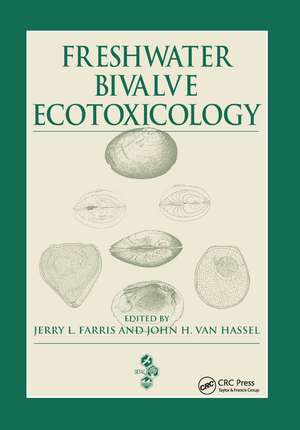Freshwater Bivalve Ecotoxicology
Editat de Jerry L. Farris, John H. Van Hasselen Limba Engleză Paperback – 23 sep 2019
This book lays the groundwork with discussions of topics such as impact assessment, toxicokinetics, biomarkers, and pollution tolerance. The authors then explore fundamental concepts surrounding responses measured in freshwater bivalves as a consequence of chemical exposures or accumulated contaminants in target organs or tissues. They highlight the difficulties encountered with the laboratory culture of these organisms for toxicity testing or other controlled experiments, and examine the use of surrogate test organisms to relate sensitivities of response and reduce pressure on already impacted fauna. The book also reviews innovative field research using in situ bivalve toxicity testing, discusses effects-oriented tissue contaminant assessment, and concludes with threefour specific laboratory or combined field/laboratory ecotoxicology studies.
A summary of methods from more than 75 laboratory toxicity studies conducted with freshwater mussels, the book provides an overview of a standardized method for conducting water-only acute and chronic laboratory toxicity tests with glochidia juvenile freshwater mussels. It focuses on studies that report measured contaminant treatments, had robust experimental designs, including replication of control and contaminant treatments, and were publish
Preț: 500.72 lei
Preț vechi: 589.09 lei
-15% Nou
Puncte Express: 751
Preț estimativ în valută:
95.84€ • 104.14$ • 80.56£
95.84€ • 104.14$ • 80.56£
Carte tipărită la comandă
Livrare economică 21 aprilie-05 mai
Preluare comenzi: 021 569.72.76
Specificații
ISBN-13: 9780367389895
ISBN-10: 0367389894
Pagini: 404
Dimensiuni: 178 x 254 x 21 mm
Greutate: 0.77 kg
Ediția:1
Editura: CRC Press
Colecția CRC Press
ISBN-10: 0367389894
Pagini: 404
Dimensiuni: 178 x 254 x 21 mm
Greutate: 0.77 kg
Ediția:1
Editura: CRC Press
Colecția CRC Press
Public țintă
Academic and Professional Practice & DevelopmentCuprins
Freshwater Bivalve Ecotoxicology. A Review of the Use of Unionid Mussels as Biological Indicators of Ecosystem Health. A Brief Look at Freshwater Mussel (Unionacea) Biology. Propagation and Culture of Freshwater Mussels. Laboratory Toxicity Testing with Freshwater Mussels. In-Situ Toxicity Testing of Unionids. Unionid Mussel Sensitivity to Environmental Contaminants. Toxicokinetics of Environmental Contaminants in Freshwater Bivalves. Linking Bioaccumulation and Biological Effects to Chemicals in Water and Sediment: A Conceptual Framework for Freshwater Bivalve Ecotoxicology. Biomarker Responses of Unionid Mussels to Environmental Contaminants. Case Study: Comparison of Asian Clam (Corbicula fluminea) In Situ Testing to Several Nontarget Test Organism Responses to Biocidal Dosing at a Nuclear Power Plant. Case Study: Discrimination of Factors Affecting Unionid Mussel Distribution in the Clinch River, Virginia, USA. Case Study: Impact of Partially Treated Mine-Water on an Ohio River (USA) Mussel Bed: Use of Multiple Lines of Evidence in Impact Analysis. Case Study: Sensitivity of Mussel Glochidia and Regulatory Test Organisms to Mercury and a Reference Toxicant.
Notă biografică
Jerry L. Farris, John H. Van Hassel
Descriere
This book covers techniques and approaches for assessing suspected contaminant impact upon freshwater bivalves. The editors incorporate expertise on research topics and management issues from a cross section of active scientists in the field. The resulting array of viewpoints provides a valuable tool drawn from internal and external peer reviews. They explore advances in general monitoring of population responses to stressors and fundamental concepts of ecotoxicology specific to burrowing bivalves. They also provide insights that offer direction and priority for resolving specific problems challenging protection and conservation efforts.
